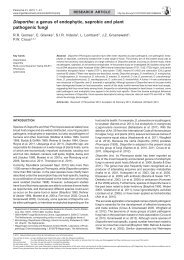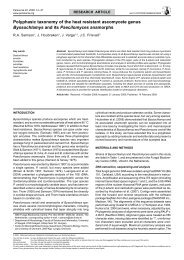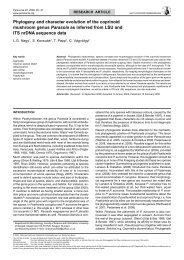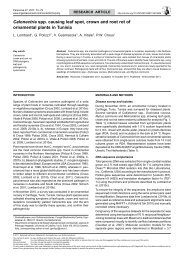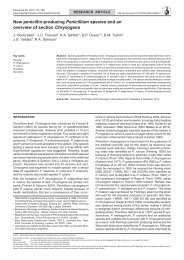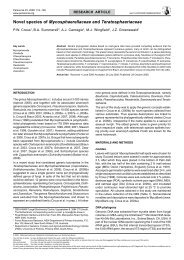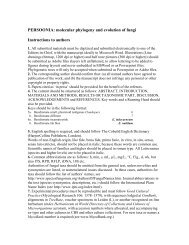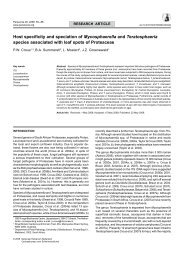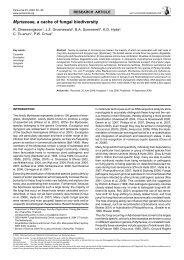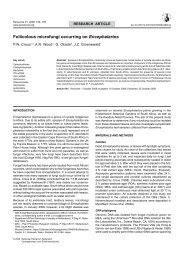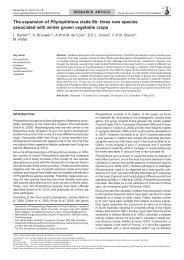Phylogeny and taxonomy of obscure genera of microfungi - Persoonia
Phylogeny and taxonomy of obscure genera of microfungi - Persoonia
Phylogeny and taxonomy of obscure genera of microfungi - Persoonia
Create successful ePaper yourself
Turn your PDF publications into a flip-book with our unique Google optimized e-Paper software.
P.W. Crous et al.: Obscure <strong>genera</strong> <strong>of</strong> micr<strong>of</strong>ungi<br />
155<br />
a<br />
b<br />
c<br />
d<br />
e<br />
f<br />
g<br />
Fig. 12 Trochophora fasciculata (CPC 10280). a. Leaf spots on Daphniphyllum; b. colony on MEA; c. fasciculate conidiophores; d. conidiophores <strong>and</strong> conidiogenous<br />
cells; e–g. conidia. — Scale bars = 10 µm.<br />
Verrucisporota daviesiae (Cooke & Massee) Beilharz & Pascoe,<br />
Mycotaxon 82: 360. 2002<br />
Basionym. Cercospora daviesiae Cooke & Massee, Grevillea 18: 7.<br />
1889.<br />
Teleomorph. Mycosphaerella daviesiicola Beilharz & Pascoe, Mycotaxon<br />
82: 364. 2002.<br />
Characteristics in culture — On MEA erumpent, spreading<br />
with folded surface, <strong>and</strong> sparse aerial mycelium <strong>and</strong> even,<br />
lobate margin; surface iron-grey to olivaceous-grey; reverse<br />
iron-grey; colonies reaching 7 mm diam after 2 wk. On PDA<br />
erumpent, spreading, with moderate aerial mycelium <strong>and</strong><br />
uneven margins; surface white in middle, olivaceous-grey in<br />
outer region, iron-grey underneath; colonies reaching 8 mm<br />
diam after 2 wk. On OA erumpent, spreading, with moderate<br />
aerial mycelium <strong>and</strong> uneven margin; surface white in middle,<br />
olivaceous-grey in outer region; colonies reaching 8 mm diam<br />
after 2 wk.<br />
Specimen examined. Australia, Victoria, on living leaves <strong>of</strong> Daviesia<br />
mimosoides (≡ D. cormybosa var. mimosoides), V. & R. Beilharz, VPRI 31767<br />
= CBS 116002.<br />
Notes — The type species <strong>of</strong> the genus Stenella, S. araguata,<br />
clusters in the Teratosphaeriaceae (Crous et al. 2007a),<br />
<strong>and</strong> thus the majority <strong>of</strong> the stenella-like anamorphs in the<br />
Mycosphaerellaceae, will need to be placed in another genus.<br />
One option would be Zasmidium (Arzanlou et al. 2007), which<br />
clusters in the Mycosphaerellaceae, along with Verrucisporota<br />
(Fig. 1). This clade, however, is neither morphologically nor<br />
phylogenetically well resolved, <strong>and</strong> taxa need to be added to<br />
improve the phylogeny before a reasonable assessment can<br />
be made. The ITS sequence <strong>of</strong> this species is distinct from the<br />
other two species <strong>of</strong> this genus treated in this paper (Table 1).<br />
Verrucisporota grevilleae Crous & Summerell, sp. nov. —<br />
MycoBank MB509523; Fig. 13<br />
Differt a Verrucisporota protearum conidiis angustioribus et longioribus, (30–)<br />
50–65(–80) × (5–)6–7 µm, et conidiophoris brevioribus, (35–)80–120(–160)<br />
× (5–)6–7 µm.<br />
Etymology. Named after the host genus on which it occurs, Grevillea.<br />
Leaf spots angular, elongated, amphigenous, 1–2 mm wide,<br />
3–10 mm long, medium to dark brown to black, discrete.<br />
Mycelium immersed <strong>and</strong> superficial, hyphae medium brown,<br />
septate, verrucose, 1.5–3 µm wide. Stroma up to 60 µm wide<br />
<strong>and</strong> 40 µm high, forming in substomatal cavities, becoming<br />
erumpent, cells brown, thick-walled, pseudoparenchymatous.<br />
Conidiophores macronematous, mononematous, caespitose,<br />
emerging through the stomata, simple, flexuous, <strong>of</strong>ten geniculate-sinuous,<br />
4–7-septate, mainly smooth, dark brown, from<br />
a bulbous base tapering towards the apex, but <strong>of</strong>ten becoming<br />
more swollen, <strong>and</strong> also verrucose at the apex, (35–)80–120<br />
(–160) × (5–)6–7 µm. Conidiogenous cells cylindrical, becoming<br />
geniculate, integrated, terminal, polyblastic, proliferating<br />
sympodially, 20–45 × 5–7 µm, with conspicuous, cicatrised,<br />
protuberant, conidiogenous loci, 3 µm diam. Conidia subcylindrical,<br />
narrowing slightly to an obtuse apex (frequently<br />
swollen), <strong>and</strong> with a truncate base with a distinctly thickened,<br />
darkened, somewhat refractive hilum, 3 µm wide, red-brown,<br />
straight or curved, with 3–7(–12) mainly unconstricted eusepta,<br />
thick-walled, verrucose, (30–)50–65(–80) × (5–)6–7 µm. Conidiophores<br />
frequently arising from brown, erumpent spermatogonia,<br />
up to 150 µm wide. Spermatia hyaline, smooth, bacilliform,<br />
4–6 × 1–1.5 µm.<br />
Characteristics in culture — Colonies on MEA erumpent,<br />
with sparse aerial mycelium; margins feathery, crenate; surface



